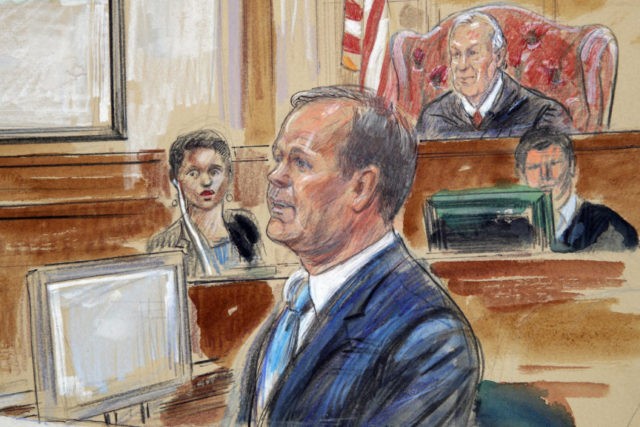WASHINGTON (AP) — Donald Trump’s inaugural committee pushed back hard last summer on questions about whether the unprecedented $107 million budget for the event was fraught with cost overruns and misspending. A top inauguration official assured The Associated Press that spending had been restrained and monitored.
In court last week, that same official — Rick Gates — acknowledged that he personally may have pocketed some of the inaugural committee’s money.
Gates, the government’s star witness in former Trump campaign chairman Paul Manafort’s financial fraud trial, admitted to Manafort’s lawyers that he “possibly” wrongfully submitted personal expenses to the inaugural committee for reimbursement.
Though only a footnote to Gates’ disclosure of tax fraud, extramarital affairs and embezzlement from Manafort, the admission raised new questions about how well the inaugural committee tracked its own spending and why Gates was chosen for a top inauguration job in the first place.
It’s not clear how much money Gates may have pocketed or whether his testimony will prompt the committee to review spending, especially given Gates acknowledged stealing hundreds of thousands of dollars from Manafort through fake expenses. Publicists for Tom Barrack, a real estate magnate who hired Gates after the inauguration, declined to address those issues publicly when contacted by the AP. They offered written answers to questions on the condition that those answers not be cited in the story, but the AP declined.
Gates did not respond to text messages from the AP and his voicemail was full.
Both before and after revelations of busted budgets at Trump’s inaugural committee, Barrack and committee spokespeople downplayed Gates’ role. But Gates oversaw the day-to-day planning of the event as a top lieutenant of Barrack, according to four inauguration staffers and vendors. All requested anonymity on the grounds that discussing inaugural committee affairs would hurt their careers in Republican politics or event planning.
“If there was an issue, it went to Gates,” said one person who worked on the inauguration with him.
According to a committee source and a vendor who had access to the inaugural committee’s early planning documents, the committee’s initial plans were modeled on President Barack Obama’s 2013 inauguration — an event that cost just over $40 million.
How the Trump inaugural committee’s costs rose to $100 million — despite throwing fewer events than Obama’s team, and hosting them in largely the same venues — is difficult to explain, even taking into account the $700,000 organizers spent on entertainment and the $1 million lawn coverings that Trump later blamed for making his crowd look small.
Greg Jenkins, who helped organize President George W. Bush’s first inauguration and ran the second, shared some of his 2005 costs with the AP last year. A major concert on the National Mall was budgeted for $2 million, and the president’s “military salute” ran $2.5 million. Then there were nine separate inaugural balls — at a total cost of $7.7 million — and three candlelight dinners at $1.5 million each. The cost of the events, in total: $16.7 million.
Trump’s inauguration, meanwhile, threw just three balls, and its welcome concert alone cost $25 million, the AP reported last fall.
In the statement released last summer, Gates relayed Barrack’s confidence in the inauguration finances process and called the $107 million budget “a tribute to the generosity of the American people.”
Beyond the money spent on the inauguration, the statement said that “millions of dollars of reserve funds will be allocated to various charities, institutions and foundations in an amount that surely will exceed any previous inauguration.”
Some of his former campaign colleagues expressed surprise to the AP when he was selected for a top inauguration job given questions about his past work with Manafort — and existing accusations inside the Trump campaign that Gates tried to misspend campaign funds.
In November of 2017, two campaign sources told the AP that Gates had unsuccessfully attempted to transfer $5 million to a TV advertising vendor for commercials that the campaign had never approved. The incident, which occurred in the spring of 2016, was later featured in former campaign manager Corey Lewandowski’s score-settling memoir of the campaign, “Let Trump be Trump.”
Separately, White House general counsel Don McGahn, who was Trump’s campaign counsel, also pressed Gates to explain how the campaign spent $730,000 on an obscure and recently created direct mail firm, Left Hand Enterprises. Much of that money, records obtained by the AP show, was used to send campaign mailers to voters in safe Republican states — after Trump had already clinched his primary victory.
McGahn told the AP in October 2016 that he had no reason to doubt the money had been spent on mailers. He did not respond to emails requesting comment last week.

COMMENTS
Please let us know if you're having issues with commenting.